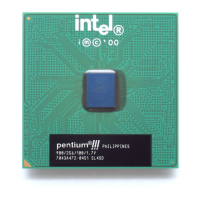Introduction
R
Intel
®
Pentium
®
4 Processor / Intel
®
850 Chipset Family Platform Design Guide 19
1.2 Conventions and Terminology
This section defines conventions and terminology that will be used throughout this document.
Table 1. Platform Conventions and Terminology
Term Definition
Aggressor A network that transmits a coupled signal to another network is the aggressor network.
AGTL+ The processor System Bus uses a bus technology called AGTL+, or Assisted Gunning
Transceiver Logic. AGTL+ buffers are open-drain and require pull-up resistors that provide
the high logic level and termination. AGTL+ output buffers differ from GTL+ buffers with the
addition of an active pMOS pull-up transistor to “assist” the pull-up resistors during the first
clock of a low-to-high voltage transition.
Bus Agent A component or group of components that, when combined, represent a single load on the
AGTL+ bus.
Corner Describes how a component performs when all parameters that could impact performance
are adjusted simultaneously to have the best or worst impact on performance. Examples of
these parameters include variations in manufacturing process, operating temperature, and
operating voltage. Performance of an electronic component may change as a result of
(including, but not limited to): clock to output time, output driver edge rate, output drive
current, and input drive current. The “slow” corner is defined as a component operating at its
slowest, weakest drive strength performance. The “fast” corner is defined as a component
operating at its fastest, strongest drive strength performance. Operation or simulation of a
component at its slow corner and fast corner is expected to bound the extremes between
slowest, weakest performance and fastest, strongest performance.
Crosstalk The reception on a victim network of a signal imposed by aggressor network(s) through
inductive and capacitive coupling between the networks.
• Backward Crosstalk – coupling that creates a signal in a victim network that travels in the
opposite direction as the aggressor’s signal.
• Forward Crosstalk – coupling that creates a signal in a victim network that travels in the
same direction as the aggressor’s signal.
• Even Mode Crosstalk – coupling from single or multiple aggressors when all the
aggressors switch in the same direction that the victim is switching.
• Odd Mode Crosstalk – coupling from single or multiple aggressors when all the
aggressors switch in the opposite direction that the victim is switching.
Flight Time Flight time is a term in the timing equation that includes the signal propagation delay, any
effects the system has on the T
CO
of the driver, plus any adjustments to the signal at the
receiver needed to guarantee the setup time of the receiver. More precisely, flight time is
defined to be:
• Time difference between a signal at the input pin of a receiving agent crossing the
switching voltage (adjusted to meet the receiver manufacturer’s conditions required for
AC timing specifications; e.g., ringback, etc.) and the output pin of the driving agent
crossing the switching voltage when the driver is driving a test load used to specify the
driver’s AC timings.
• Maximum and Minimum Flight Time – Flight time variations can be caused by many
different variables. The causes include variation of the board dielectric constant, changes
in load condition, crosstalk, power noise, variation in termination resistance and
differences in I/O buffer performance as a function of temperature, voltage and
manufacturing process. Some other causes include effects of Simultaneous Switching
Output (SSO) and packaging effects.
• Maximum flight time is the largest acceptable flight time a network will experience under
all variations of conditions.
• Minimum flight time is the smallest acceptable flight time a network will experience under
all variations of conditions.

